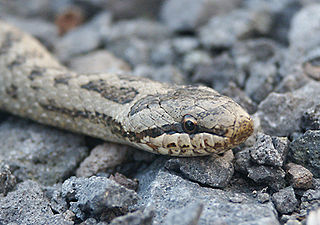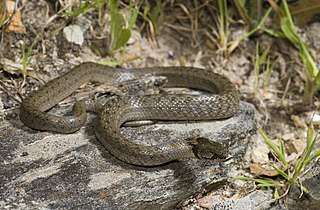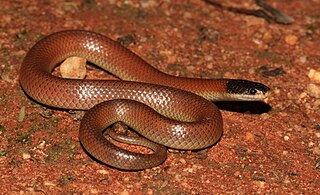
The milk snake or milksnake, is a species of kingsnake; 24 subspecies are currently recognized. Lampropeltis elapsoides, the scarlet kingsnake, was formerly classified as a 25th subspecies, but is now recognized as a distinct species. The subspecies have strikingly different appearances, and many of them have their own common names. Some authorities suggest that this species could be split into several separate species. They are not venomous to humans.

The Mexican blind lizard is a species of legless lizard in the family Dibamidae, and the only species in the genus Anelytropsis. It is endemic to Mexico. They look like Amphisbaenia, but are in fact, only distantly related.

The smooth snake is a species of non-venomous snake in the family Colubridae. The species is found in northern and central Europe, but also as far east as northern Iran. The Reptile Database recognizes two subspecies as being valid, including the nominotypical subspecies described here.

Drymarchon is a genus of large nonvenomous colubrid snakes, commonly known as indigo snakes or cribos, found in the Southeastern United States, Central America, and South America.

Hydrodynastes gigas is a New World species of large, rear-fanged, Dipsadin snake endemic to South America. It is commonly and alternatively known as the false water cobra and the Brazilian smooth snake. The false water cobra is so named because when the snake is threatened it "hoods" as a true cobra does. Unlike a true cobra, though, it does not rear up, but remains in a horizontal position. No subspecies are currently recognized as being valid.

The eastern hog-nosed snake, is a species of mildly venomous rear-fanged snake in the family Colubridae. The species is endemic to North America. There are no subspecies that are recognized as being valid.

Vipera latastei, known as Lataste's viper, the snub-nosed viper, and the snub-nosed adder, is a species of venomous snake in the subfamily Viperinae of the family Viperidae. The species is endemic to the Iberian Peninsula and northwestern Maghreb. Three extant subspecies and one extinct subspecies are currently recognized, including the nominate subspecies described here.

The broad-headed snake is a species of venomous snake in the family Elapidae. The species is restricted to the Sydney Basin in New South Wales, Australia. It is one of three snakes in the genus Hoplocephalus, all restricted to eastern Australia. It is currently endangered in New South Wales and is listed as vulnerable under the Commonwealth Legislation.

The western three-toed skink is a species of lizard with tiny legs in the family Scincidae. It is found in the Iberian Peninsula, southern France and parts of northwestern Italy. Its natural habitats are temperate forests, temperate shrubland, Mediterranean-type shrubby vegetation, temperate grassland, sandy shores, arable land, pastureland, and rural gardens. It was first described 1829 by the French naturalist Georges Cuvier. The generic name comes from the Greek "chalcides" meaning 'copper' and the specific name is derived from the Latin "striatus" meaning 'streak'.
Macroprotodon abubakeri is a species of snake in the family Colubridae. It is one of four species in the genus Macroprotodon.

Macroprotodon is a genus of snakes in the family Colubridae. All of the member species of the genus are commonly known as false smooth snakes.

Macroprotodon cucullatus, commonly known as the false smooth snake, is a species of mildly venomous colubrid snake endemic to the Mediterranean Basin.

The Italian Aesculapian snake is a species of snake in the Colubridae family.

The Iberian worm lizard, Mediterranean worm lizard, or European worm lizard is a species of reptile in the family Blanidae of the clade Amphisbaenia. The Iberian worm lizard is locally known as cobra-cega (Portuguese), culebrilla ciega (Spanish), and colobreta cega (Catalan), all meaning "blind snake". Recent studies into the mitochondrial and nuclear genomic data of 47 isolated B. cinereus populations show rather large sequence divergence between two apparent clades, leading some researchers to call for a division of the Iberian worm lizard into two species. While little is known of B. cinereus in comparison with some other reptile species, new insight is growing about this primitive, ancestral reptile.

Dwyer's snake also known commonly as the whip snake and the variable black-naped snake, is a species of venomous snake in the family Elapidae. The species is endemic to Australia, where it is found from New South Wales to South Queensland. While closely related to Australian sea snakes, S. dwyeri is a terrestrial reptile.

Boiga schultzei, commonly known as the Schultze's blunt-headed tree snake, is a species of snake in the family Colubridae. The species is endemic to the Philippines.
The smooth snake is a species of non-venomous snake found in northern and central Europe.

















